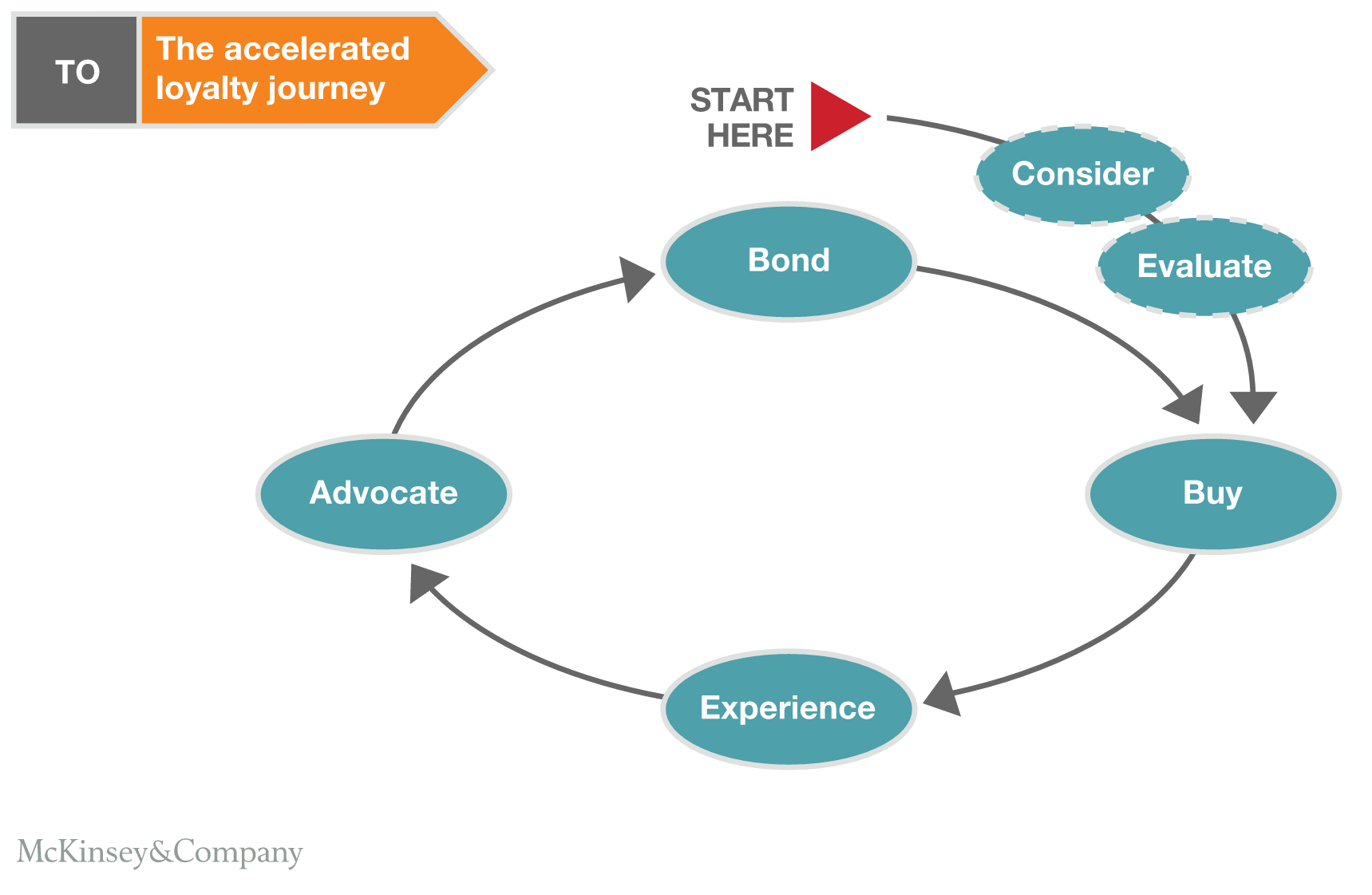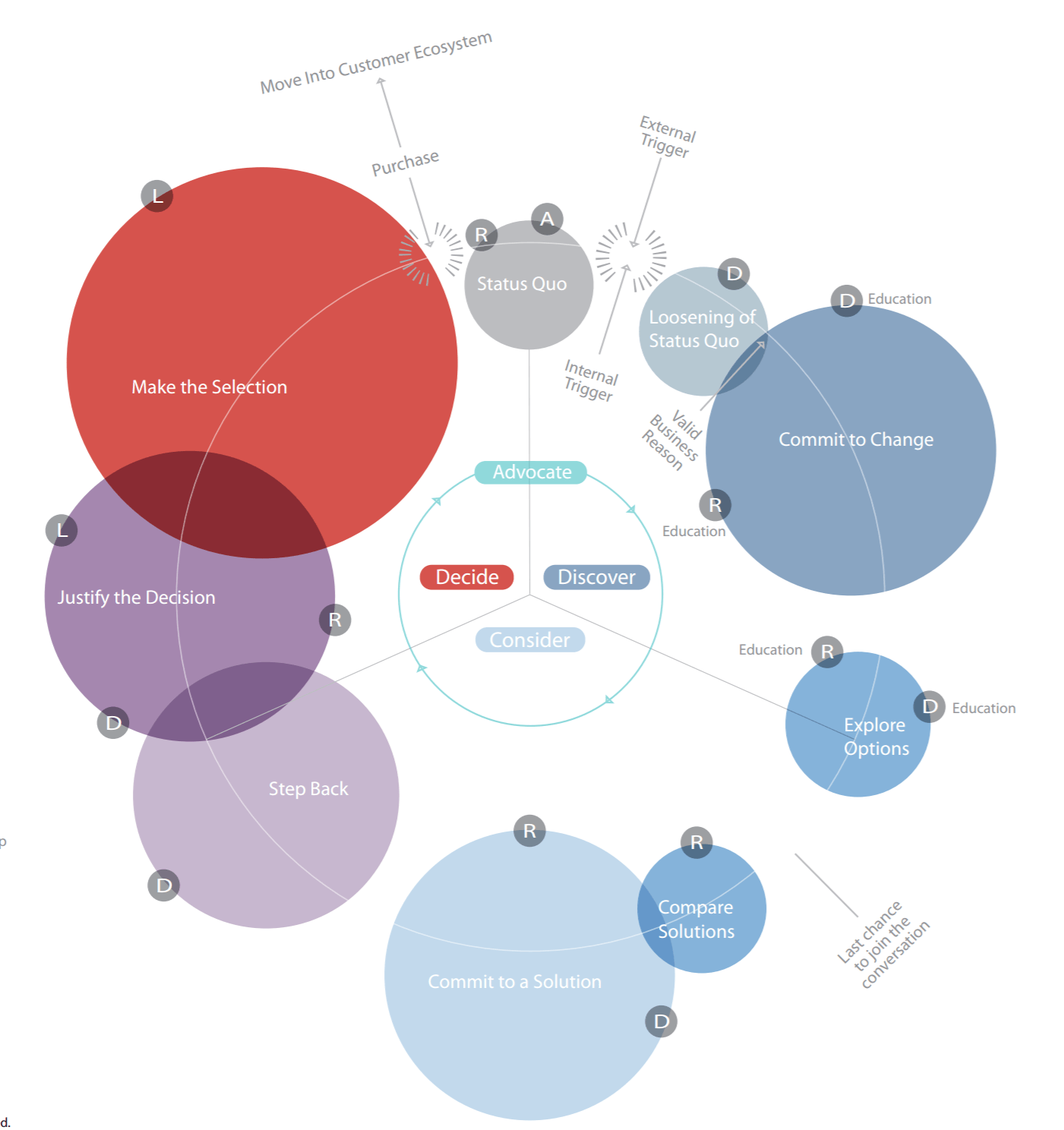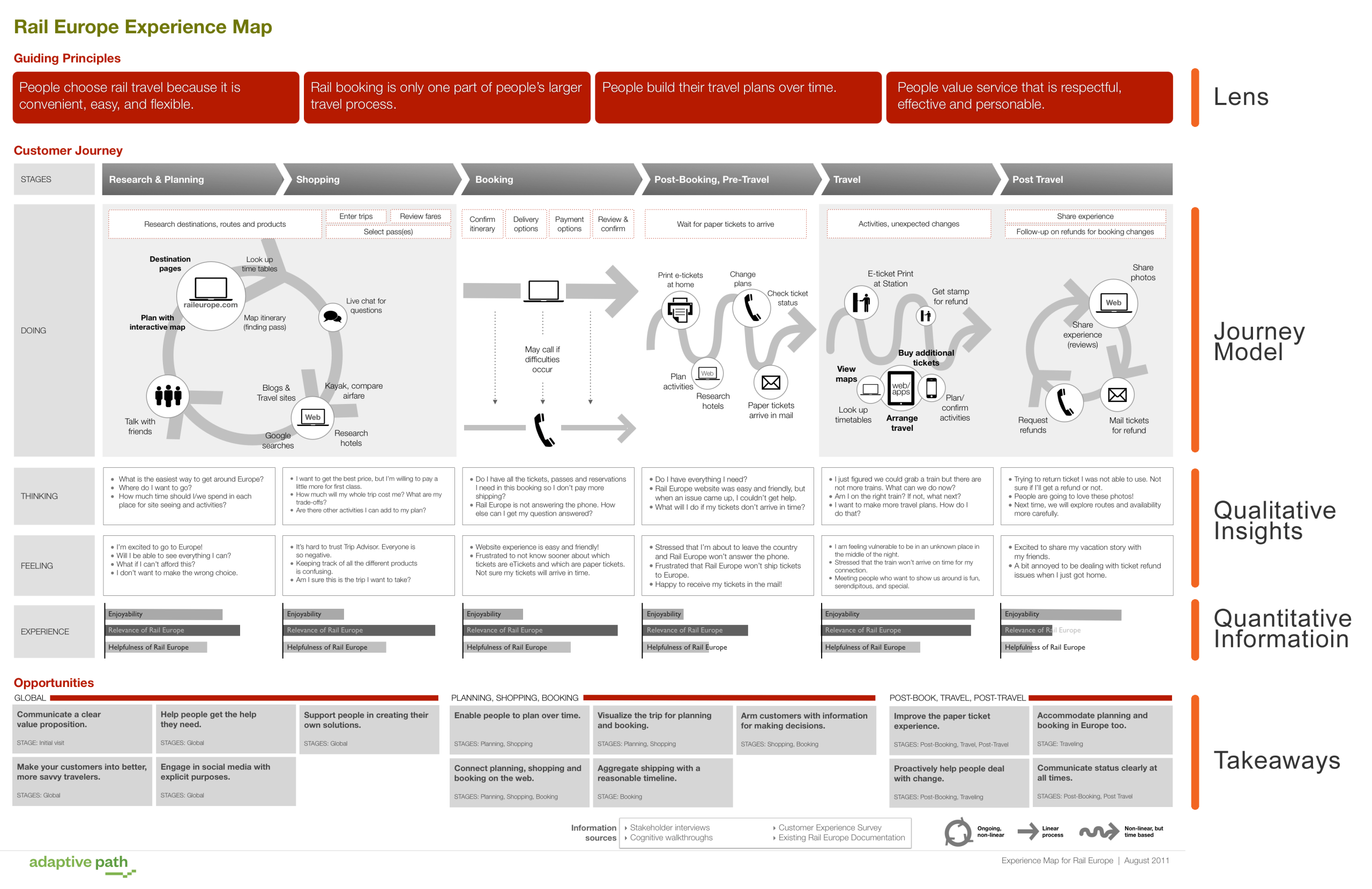*Positioning
Customer journey as the basis for communication and sales process

How many touchpoints do you have with customers before they make a purchase? According to Dr. Jeffrey Lant, the “Rule of 7” states that you need at least seven touchpoints in 18 months before a purchase follows. This statement seems completely unfounded and made up, but of course, it does have a kernel of truth. Especially in B2B, many touchpoints are more the rule than the exception. The customer journey, of course, varies per product, company, customer group, and industry.
Therefore, we prefer to think in terms of customer journeys rather than touchpoints. It’s about the circular path that the customer travels from introduction to purchase and, not to forget, follow-up and evaluation. In this article, we delve deeper into that customer journey. We discuss the definition and meaning, provide examples, explain models, and tell you how to actually implement the customer journey in your organization and make sure it supports your brand’s positioning.
Customer journey example from hell
Imagine you’re standing in front of the dairy section at Albert Heijn, trying to decide which yogurt to buy. After a minute and a half, you make up your mind and grab a pack of the store brand full-fat yogurt. You head to the checkout and pay for your purchase.
The next morning, you walk into a Starbucks to grab a coffee, and who do you see behind the counter? A salesperson from Albert Heijn, asking if you want to buy that same pack of yogurt you bought yesterday. Surprised, you explain that you already bought it. The salesperson says, “Okay,” and walks away. Half an hour later, while shopping at the Hema for some household items, that same salesperson from Albert Heijn appears out of nowhere, pushing the yogurt again: “Do you want to buy this pack of yogurt!?”
You’d start to question your sanity in such a situation, wouldn’t you?
This might sound pretty bizarre, but unfortunately, it’s an all-too-common customer journey experience online.
Let’s say your vacuum cleaner has broken down, and you spend an hour researching different brands and reading reviews before finally deciding on a new one. The next day, it’s delivered, and it’s exactly what you wanted. However, for the next few days and weeks, you’re constantly being pursued by all three of the brands you researched, including the one you actually purchased from! You can’t read an article on nu.nl without being bombarded with ads for five more vacuum cleaners, and it’s enough to drive you crazy.
How does this experience affect your perception of and experience with these brands?
Customer journey as the intersection of marketing and sales
Even in a B2B environment, this phenomenon is commonplace. All relationships are thrown into one file and receive the same mailings and invitations, even long-standing customers! The prospect you met two months ago at a trade show receives the same message as the customer who has been purchasing your product for 10 years. What is going wrong here?
- The prospect is at a very different stage in their customer journey than the existing customer. They are still exploring and are not quite sure how they are going to make their choice. They would appreciate a demonstration, whitepaper, or presentation.
- The long-standing customer already knows all the ins and outs of your product, they can even teach your engineers a thing or two! They would benefit more from new tips and tricks from other customers or an invitation to a relationship day.
Your communication does not sufficiently match the stage of the customer journey that both customers are in. The big danger is that this would cause them to drop off or look for another supplier who does have it in order. You can prevent this by mapping out the customer journey of your company and aligning all communication with it. That is where we start.
Customer journey definition and meaning
To begin with, the definition of customer journey:
The customer journey is the collection of phases that a customer goes through in their interaction with a company.
A customer journey represents all of a customer’s contact with your company. This quickly becomes a complex model that affects all departments of the organization. In the past, and this still applies to many companies, the customer journey reflected the structure of the selling company:
- Marketing
The first contact with a company at an event or webinar and the subsequent mailings and possible contact - Sales
The relationship becomes more serious, the potential customer considers a purchase - Production
Delivery, installation or realization of the purchase - Customer service
Aftercare and assistance with product use - Relationship maintenance
“Keeping warm”/maintaining the built-up customer relationship, which may again lead to a new Marketing & Sales cycle
But is this also how the customer thinks about their contact with your company?
Probably not, and that’s the challenge. It often goes wrong, as in our previous example, at the transition between different phases. Sales may do their job well, but if it does not connect with the efforts of marketing, you’re one step behind. The customer journey, therefore, works from the perspective of the customer, how do they make their choices? By responding to this, you increase the return on the efforts of the various departments. Roughly speaking: you sell more.
But what does your customer journey look like? There are different models that you can use as a basis.’
Customer journey model: make your choice
In fact, every customer journey is unique. One person may spend weeks browsing online before making contact, while another may call right away. Your customer journey needs to cover both scenarios. You map out the different phases that your target audience goes through and then determine what they need during each phase. You probably already have a pretty good idea of what they need.
But to create a complete customer journey, it’s probably useful to work from an existing model. That way, you can be sure that you’re not skipping any phases, and every department knows what’s expected of them at all times. There are a lot of models out there, but we’ll mention four here. Take a moment to consider each one and think about whether it’s a good fit for your company.
KOPAN
Stands for Know, Observe needs, Present, Close, Aftercare. (translated from: Kennismaken, Opsporen behoefte, Presenteren, Afsluiten, Nazorg). This is a traditional, lesser-known sales model, but it can be easily applied to today’s sales process with a little imagination. For example, if you don’t succeed in making a good first impression, it will be very difficult to identify the customer’s needs.’
AIDA customer journey model (wikipedia)
Stands for Attention, Interest, Desire, Action. The traditional sales and marketing model that states that the potential customer must first have attention before interest can be aroused and so on. Why is this model somewhat outdated? Because it does not consider everything after the Action, while in this day and age, after-sales service and reputation are essential.
McKinsey Klantreis Model
 McKinsey states that companies can no longer simply react to the (changing) customer, but must play an active role in shaping and directing this. McKinsey clearly defines the circular nature of a customer journey and the different phases involved. Consider and Evaluate are the lead-in processes, within the circular customer journey they are limited to Purchase, Experience, Advocate and Bonding.
McKinsey states that companies can no longer simply react to the (changing) customer, but must play an active role in shaping and directing this. McKinsey clearly defines the circular nature of a customer journey and the different phases involved. Consider and Evaluate are the lead-in processes, within the circular customer journey they are limited to Purchase, Experience, Advocate and Bonding.
Babcock Jenkins customer journey Model

Babcock Jenkins presents a very comprehensive customer journey model (download in pdf) and distinguishes three core phases: Discover, Consider, Decide, around which Advocate revolves as a continuous process. The three core phases are then divided into 11 decision points that determine whether the next phase in the customer journey is reached.
This model is our preference, especially because it is very customer-oriented and easy to apply to different companies. The first step in using this model? Answer the questions on the right side of the pdf for your company.
Customer journey: role of website and content
The more you work out the customer journey model for your organization, the more you discover the answers that your customers are looking for in each phase. You use your website to provide answers to as many questions as possible, with the aim of getting the customer to the next phase, ideally resulting in a sale.
Website as a source for leads
But the reverse is also true. By analyzing the use of your website, you determine in which phase of the customer journey a particular customer is. For example:
Jan de Vries visits your website on Monday. He requests a whitepaper on the use of your product in a specific market and leaves his name and email address. You now know that he is mapping out a possible solution, but you don’t know what problem he has yet. The following week, you send him (possibly automatically) a follow-up email with three articles on specific problems that your product solves. If he reads one of these articles, it is an excellent basis for a conversation. Perhaps it is time to hand over this lead to sales?
Customer journey: impact on sales process
Thinking from the perspective of the customer journey, also known as a customer-centric approach or “Customer First”, naturally also imposes completely different demands on salespeople. In the past, the salesperson was a “spy” or a “door-kicker”, but nowadays the sales role is more that of an ambassador. We call this the Salesperson 2.0 and wrote an entire article about it called “These salespeople will be obsolete within 5 years!”
If we apply this to the customer journey, it places the following demands on the salesperson or sales department:
- Fully aware of the previous process
A customer may have already had about 3 contacts with your organization and expects you to get straight to the point. So make sure that sales is aware of where the customer is in the customer journey and what information or knowledge you already have. But above all; make sure you know what the next step is and what it takes to take it. - Possessing in-depth and relevant knowledge
If Jan de Vries from the previous example is called, make sure he speaks to a specialist who has experience with his specific problem. - Authority
The potential customer has (probably) done his homework and is now an expert. How does he know you are too? Has the person he is speaking to have authority, has the customer come across her name during his research? - Accessible
And that goes beyond answering the phone. Being accessible means answering a question within a timeframe that the customer can benefit from. Being accessible also means that the customer can reach you via channels that he likes. Why wouldn’t you be able to ask a question on Twitter?
We elaborate on this in our article about the Salesperson 2.0.
Customer Journey Example from Practice
The following example of a customer journey from Rail Europe clearly demonstrates how a customer journey can be practically implemented.

Customer journey developed by Adaptive Path
Aan de slag met jouw klantreis
What is the first step to mapping out the customer journey that suits your business? Here are a few considerations:
- Talk to sales. Take the time to talk to your sales colleagues and map out the phases of their sales process. What questions do their customers ask, what objections do they bring to the table, what decision-making factors are decisive etc.
- Analyze the website. What information is currently being searched for and found on the website, when do visitors drop off, how do visitors find you? Essential input for the first phase of the customer journey.
- Interview customers. Because this is what it ultimately comes down to, they will certainly be happy to tell you exactly how they make a (purchasing) decision. Note, however, that there is often a difference between how we think we make a decision and how we actually come to a decision!
Other sources of information are of course customer service, production, field service, etc. but we limit ourselves to the marketing/sales part of the customer journey.
So far our view on the customer journey, have we forgotten an aspect or do you have a specific question? Let us know.